San Francisco’s Fog Could Be a Casualty of Climate Change… But It Could Also Be a Solution
Warming oceans and a warming planet are threatening a weather phenomenon that’s central to San Francisco’s identity and the Bay Area’s mild climate — but the fog could also be an untapped solution to the historic droughts facing California
On a chilly spring morning at the foot of the Golden Gate Bridge, a thin line of pure white fog stretched its way under the bridge deck and out toward Alcatraz.
As the waves crashed up onto the pavement at high tide, a man in a paint-spattered hoodie and a warm hat delicately traced the path of the fog with a brush, making a tiny oil painting of the fleeting image on a wooden board.
«There was this line right here,» he said. «I wasn’t thinking I was going to paint the bridge today, but I did see this, so I thought that was kind of remarkable to paint, that moment.»
Nearly as soon as he finished painting, the line of fog was gone — morphed into a totally different shape that now obscured the tops of the bridge towers, and muted their brilliant orange color.
The artist, John Paul Marcelo, quickly began to make a second painting as we talked.


Bay Area artist John Paul Marcelo paints an image of the fog-shrouded Golden Gate Bridge as he views it from the side of the road near Fort Point in San Francisco.
«Claude Monet mentioned that London was one of his favorite places to paint, because of all the shades of gray,» he mused as he mixed four different shades of gray and began applying them to the outlines of the bridge and the shore.
Landscape paintings are Marcelo’s bread and butter. And landscapes that feature the Golden Gate Bridge are among his favorites.
«It’s always changing,» he said. «I’ve painted this well over a hundred times and I never get tired of it.»
But when he’s not painting scenes of San Francisco, its fog and its landmarks, there’s another subject Marcelo often paints.
«I’ve done some natural disasters, such as Hurricane Katrina,» he said. «And more recently, the fires up in Sonoma County.»
His paintings show the destruction to homes, vehicles and neighborhoods after deadly disasters that wiped entire communities off the map. Though he documents disasters of all kinds — natural and man-made — those two are among the worst, and have both been widely attributed to climate change.
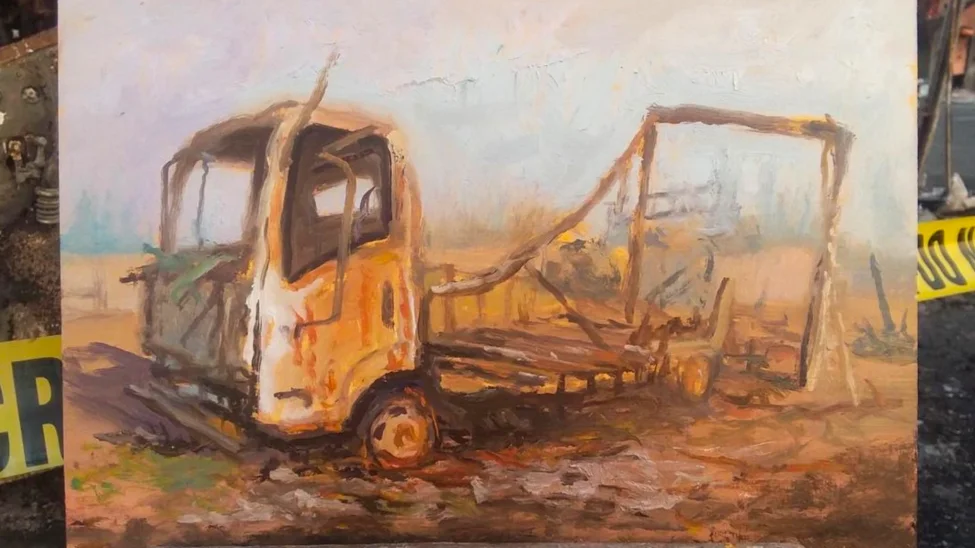

John Paul Marcelo painted this burned-out truck as part of a series of documentary paintings chronicling the destruction wrought by the Wine Country wildfires in 2017.
«Many of these places are totally uninhabitable now,» he said. «You know, we think of climate refugees in places like Africa … But this is happening here in the United States as well.»
As he put the last brushstrokes on his second painting of the day, the Golden Gate Bridge wrapped in cool gray fog seemed a world away from the scenes of rubble and destruction he sometimes paints. But with his paintings of changing fog at the Golden Gate, Marcelo might actually be documenting yet another casualty of climate change.
The Fog Was Changing
«We had a hunch that the fog was changing, but we didn’t really know how,» said Todd Dawson, a plant ecology professor at U.C. Berkeley.
We spoke in a grove of redwood trees outside Dawson’s office, as a cool breeze from the west filtered through the foliage, bringing a slight chill to the sunny afternoon. Berkeley sits directly across the Bay from the Golden Gate Bridge, and is one of the first East Bay communities to feel a temperature drop as fog rolls into San Francisco.
FOTO
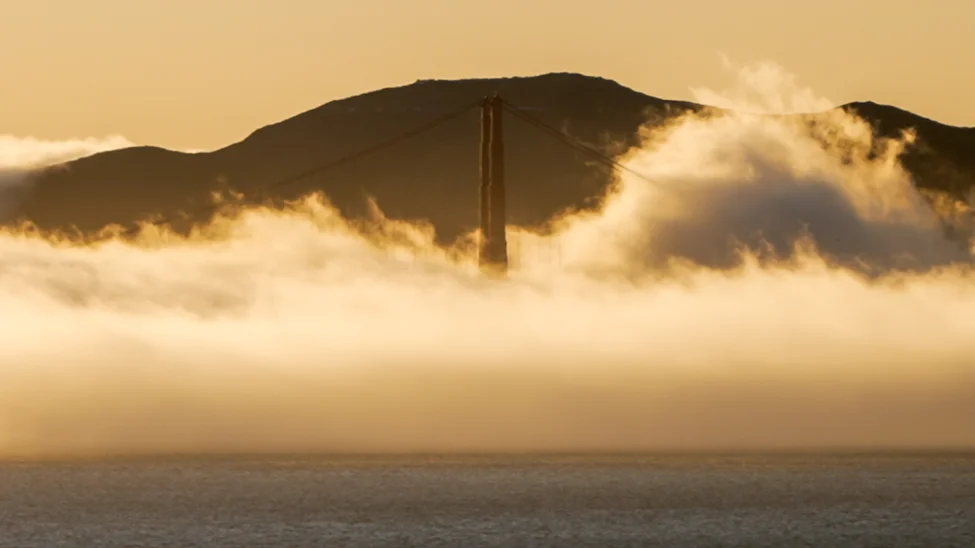

Low springtime fog enters the Golden Gate just before sunset, photographed from Treasure Island. Across the Bay, Berkeley is one of the first spots to feel a chill in the air when this happens.
Dawson knows the first signs of a fog event well — almost as well as he knows the redwood trees around his office. And he began to wonder if the two were connected.
«We got very interested in how the redwoods are interacting with the summertime fog,» he said.
Summertime fog is a well-known phenomenon in San Francisco. It’s the fog that rolls in off the ocean and over the hills in the afternoon, enveloping the city by nightfall, and hanging silently in the air until it slowly dissipates in the morning sunshine. Hike out past the Golden Gate to Land’s End, and you might find Nancy Hale — a San Francisco native who’s 70 years old, and has spent her whole life around fog.
«I mean, it’s pouring over the hill,» she said of the fog’s arrival in the mid-afternoon. «It looks like it’s almost solid because there’s so much fog.»
And just like Marcelo’s delicate brush, the fog has been painting the city in shades of gray — all summer long, for generations.
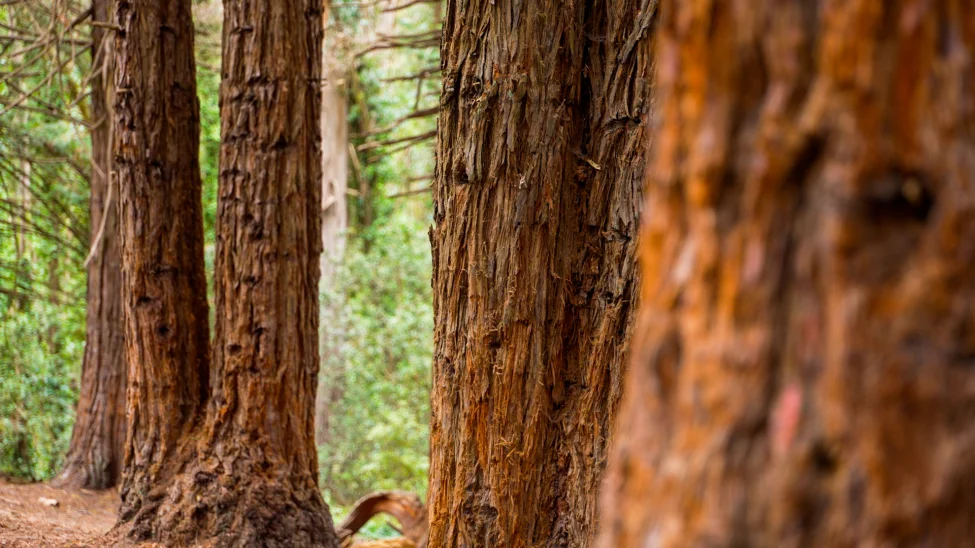

Redwood trees grow in San Francisco’s Presidio, close to the Golden Gate. Todd Dawson became interested in how much water these trees are able to gather from fog.
«The fog is our friend,» Hale said. «You could probably talk to 25 people in the city and they’d say, ‘Oh, this is my favorite place to watch the fog.»
Though a lot has changed about San Francisco in Hale’s 70 years, there’s one thing that hasn’t: Golden Gate Bridge workers still turn on the bridge’s two sets of massive foghorns manually when they notice visibility is reduced — and make a note of the weather in paper log books. Many of those logs have long since disappeared. So if Dawson wanted to find out how the fog was changing, he knew he’d need to find that data somewhere else.
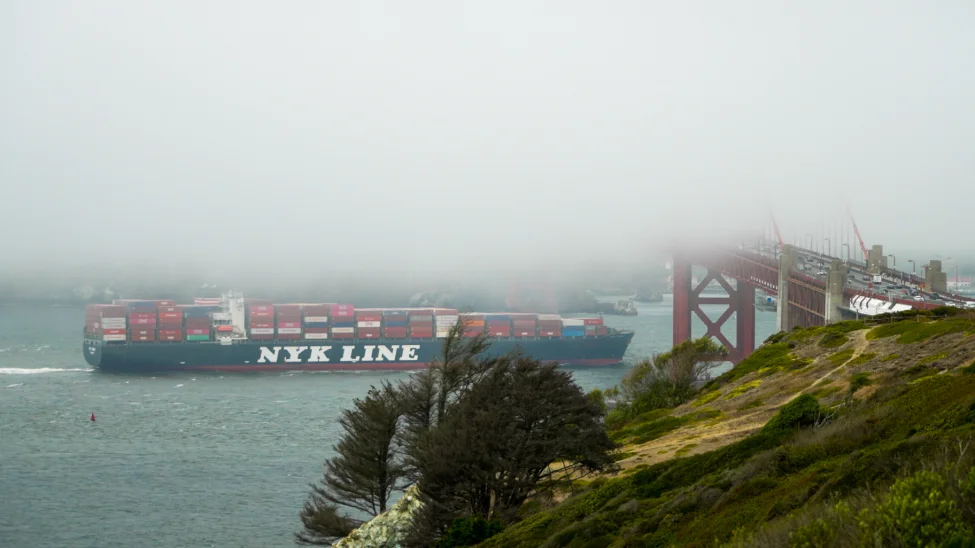

A container ship sails under the Golden Gate Bridge in the afternoon fog. Bridge workers still manually turn on the foghorns when visibility is low enough to pose a danger to vessels entering the Bay.
It turns out there’s another place where workers are always watching the sky: airports. Dawson said some of the Bay Area’s airports had meticulous records that went back decades.
«The airport records were definitely making note of fog, and they were actually noting the height of the fog,» Dawson said.
Piecing together airport data with temperature records from weather stations, Dawson and his team were able to reconstruct a historical record of fog in the Bay Area all the way back to 1951 — the year before Nancy Hale was born.
«And it really did surprise us,» Dawson said. «We saw that fog had been on a perpetual decline in coastal California. It had declined by 33 percent over a 60-year period.»


An Emirates A380 takes off into the fog at San Francisco International Airport, flying past the airport’s control tower. Airport records were instrumental in helping Dawson piece together a historical timeline of fog in the Bay Area over 60 years.
The study was widely publicized. Nancy Hale, already concerned about climate change, found the news upsetting.
«The idea that I might be giving up my fog to climate change?» she said. «It makes me somewhere between disconsolate and angry.»
When Karl the Fog Takes a Vacation
Dawson’s research raised the possibility that San Francisco’s most celebrated resident might be moving out. The fog has long been talked about as a mysterious being of sorts, with a mind and a personality all its own. But since 2010, it’s also had a name: Karl the Fog.
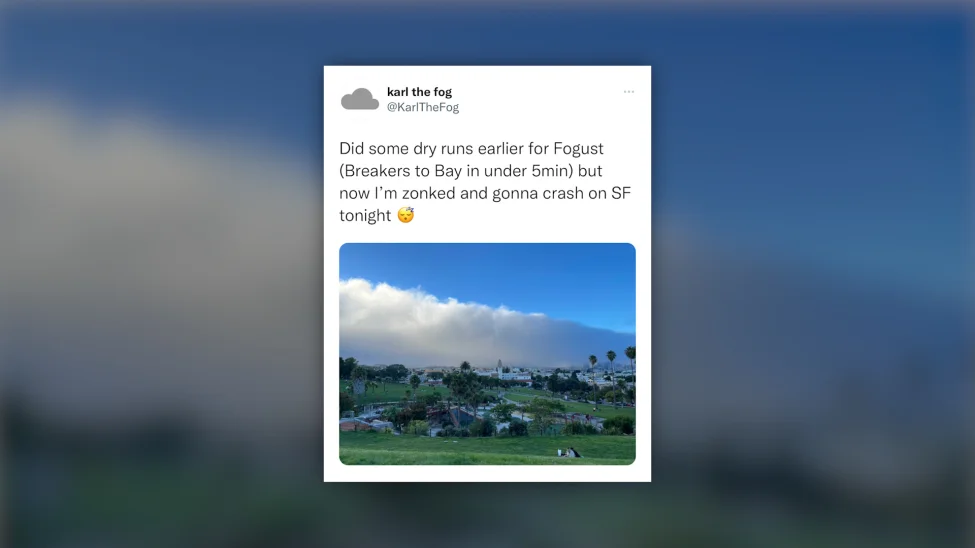

Karl the Fog has been posting his thoughts and antics on social media since Fogust of 2010.
Karl first appeared on Twitter in August of 2010, or «Fogust,» as Karl prefers to call the historically foggy month. Interviewed during that same month 12 years later, visitors to the city’s northern waterfront instantly recognized Karl’s name, and had heard all about his power to control the weather.
«It’s summertime, but it’s cold,» complained a woman in sunglasses.
«Certainly colder than I expected California to be,» a man named Johannes concurred.
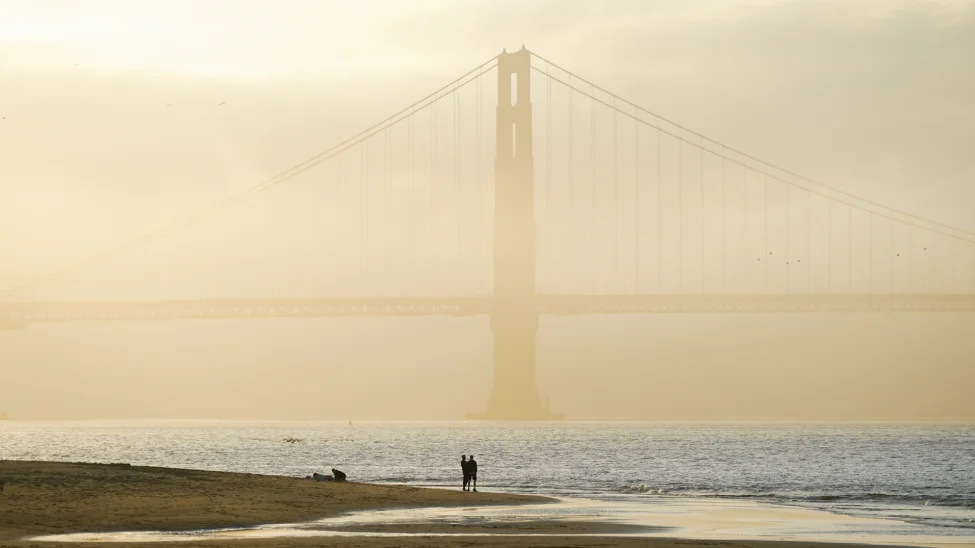

This is what Crissy Field often looks like during the month of «Fogust:» A barely-visible bridge, and only a handful of people on the beach.
Now on multiple social media platforms including Instagram, Karl the Fog had been posting photos of his cold gray antics around the city all throughout the summer of 2022. But when the end of Fogust rolled around, something unexpected happened: Karl abruptly took a vacation.
«It’s hot as hell out here,» said Julia Marshall. «I’ve never seen it this packed before.»
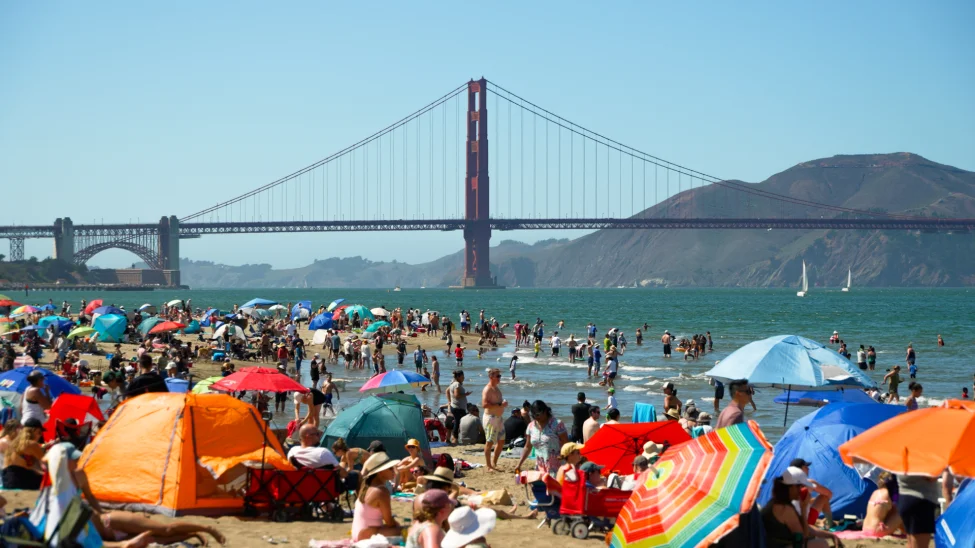

This was Crissy Field on Labor Day 2022. During an unprecedented heat wave that saw thousands fleeing to the city’s beaches to cool off, Karl the Fog was nowhere to be found.
Marshall lives near Crissy Field’s east beach, a narrow strip of sandy shoreline in the shadow of the Golden Gate Bridge that’s a favorite launching spot for windsurfers and kiteboarders. It’s often chilly and rarely crowded. But on Labor Day, umbrellas and beachgoers in colorful swimwear dotted the sand and the shallow water as far as the eye could see. Entire families stood waist deep in the chilly Bay water, attempting to find relief from a record-setting heat wave.
«It’s a lot of people out here,» said another longtime neighborhood resident. «Usually it’s cold, foggy.»
«It’s wonderful until you have to go home to sleep with no air conditioning,» said another neighbor, who added that she’d already ordered a tiny portable air conditioner for her home.
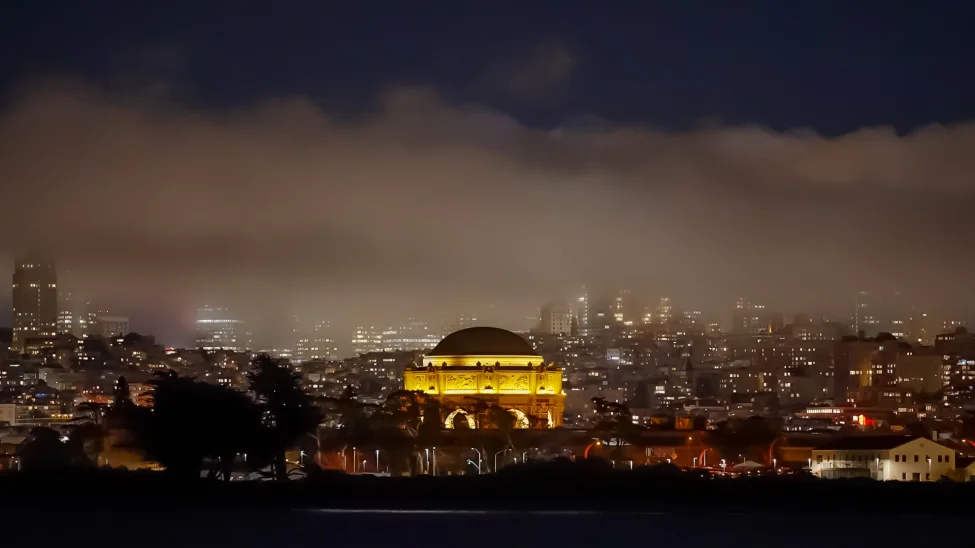

San Francisco has long been said to have its own natural air conditioning. But with a reduction in the number of foggy days per year, electric air conditioning could become more common in the city, Dawson says.
A generation ago, it was unthinkable.
«Air conditioners were not in anybody’s mind in San Francisco,» Dawson said. «Well, a decade from now, probably everybody is going to be putting A/C in their house. Because it’s going to be a lot hotter in the summertime.»
Tiny, Tiny Water Droplets
Though Karl the Fog may live in San Francisco, the effects of his presence — or absence — are felt all over the Bay Area. NBC Bay Area meteorologist Rob Mayeda has the difficult task of forecasting the fog and its effects on temperatures all over the region.
«It’s a critical tool not only for maintaining a mediterranean climate, but in some ways reducing fire danger,» he said. «And preventing inland temperatures from hitting all kinds of excessive heat warnings.»
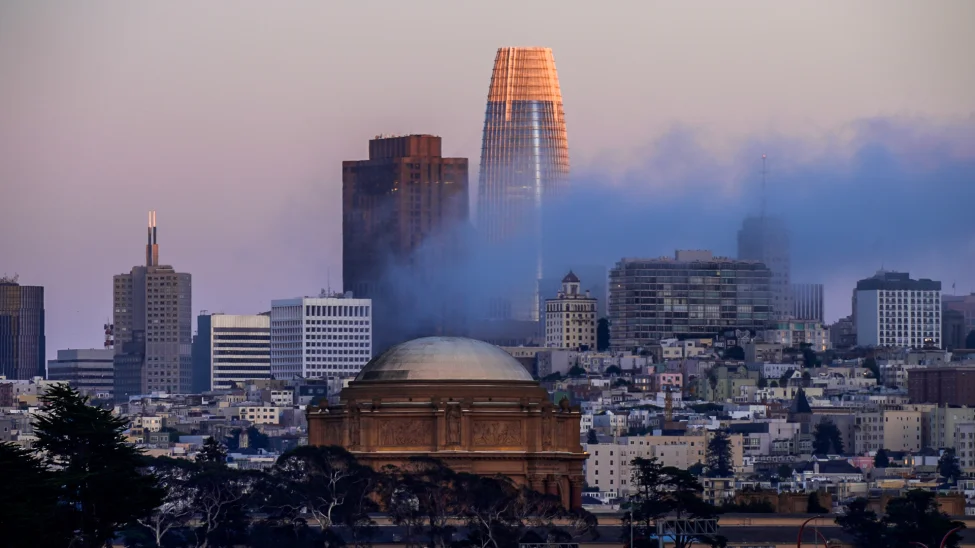

Fog can come in all different shapes and colors, but no matter its appearance, it’s always made of the same thing: tiny water droplets — much smaller than raindrops, or even the mist that comes out of a spray bottle.
Mayeda sometimes refers to fog as «ocean air conditioning» that brings both cooling and moisture to the Bay Area during the hottest and driest part of the year.
«Fog technically is tiny, tiny water droplets,» Mayeda said. «And for the Bay Area, our fog, the technical term is ‘advection fog.’ And that’s just a fancy way of saying it’s moving.»
In fact, it’s the inland heat that moves the fog, creating a vacuum that pulls it in from the ocean.
«As that warm air rises inland, the cool marine air starts pouring over the hilltops,» Mayeda said. «So it kind of comes in and replaces it.»
Dawson calls it the «fog conveyor belt,» and says the bigger the temperature difference between the cool ocean and the warm inland valleys, the faster that conveyor belt moves.
But in recent years, Mayeda says the fog has looked different. On days when the ocean is too warm, fog may not form at all. And even when it does, sometimes it’s getting flattened by stubborn areas of high pressure lingering over the Golden Gate.
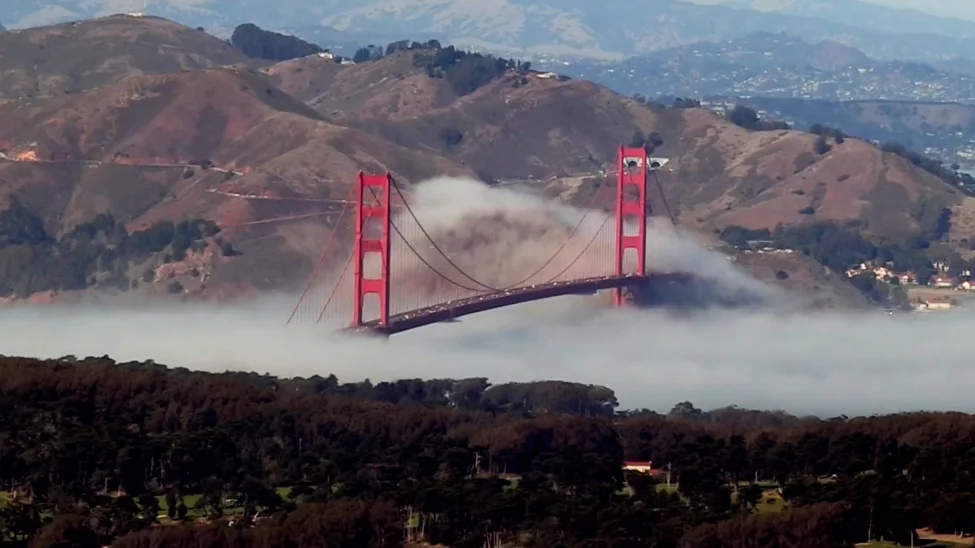

Fog pours in through the Golden Gate, rolling over the hills of the Marin Headlands. When areas of high pressure linger outside the opening of the Bay, they can affect the shape of the fog, flattening it down below the deck of the Golden Gate Bridge.
«Strong high pressure acts a bit like a ceiling,» Mayeda said. «So if the Bay Area, the mountains on all sides are like walls to the room, when high pressure is strong, it can squish that layer down pretty easily so that the cooling effects are just limited to the inner bay or the coast.»
That means on a hot summer day, San Francisco might still see some cooling effects from the flattened fog, but Livermore and Pleasanton might be left to swelter in triple-digit temperatures. Those inland areas might also miss out on the moisture carried in by the fog — moisture that, until recently, had never really been measured.
«When we started to study it, we realized that fog comes in horizontally off the ocean (but) rainfall comes in vertically,» Dawson said. «Our rainfall collectors are only getting rain, but they’re not going to get the fog.»
To measure the moisture in fog, Dawson realized he needed a new approach. The answer lay in a hand-built metal device he showed us in his office.
«This is one of the fog collector designs,» Dawson explained.
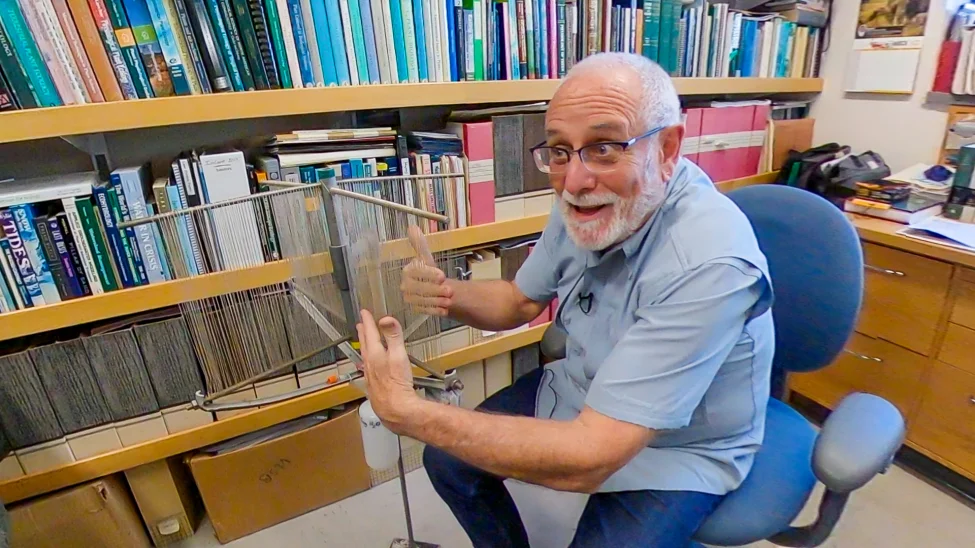

Todd Dawson shows off an easy-to-build fog collector he designed for research purposes. It uses wind and gravity to capture tiny water droplets from fog and collect them in a bottle to be analyzed later.
About three feet tall and made of commonly-available hardware store parts, the four-sided device has dozens of vertical strings like a harp, and a bottle in the center labeled «Fog H2O.» The strings are intended to catch droplets of fog carried by the wind as it blows through. The water drips down the strings into thin metal gutters, and ultimately runs down into the bottle where it can be measured and analyzed, Dawson explained.
Once the fog collectors were placed out in the elements, Dawson said it didn’t take long to make a major discovery.
«One of the things that people assumed is fog wasn’t very much,» he said. «And we came to realize that, in fact, it constitutes somewhere between 30 to 40 percent of all the water that comes into coastal California.»
It’s water that blankets the redwood trees and, Dawson later discovered, keeps them alive through the driest part of the year.
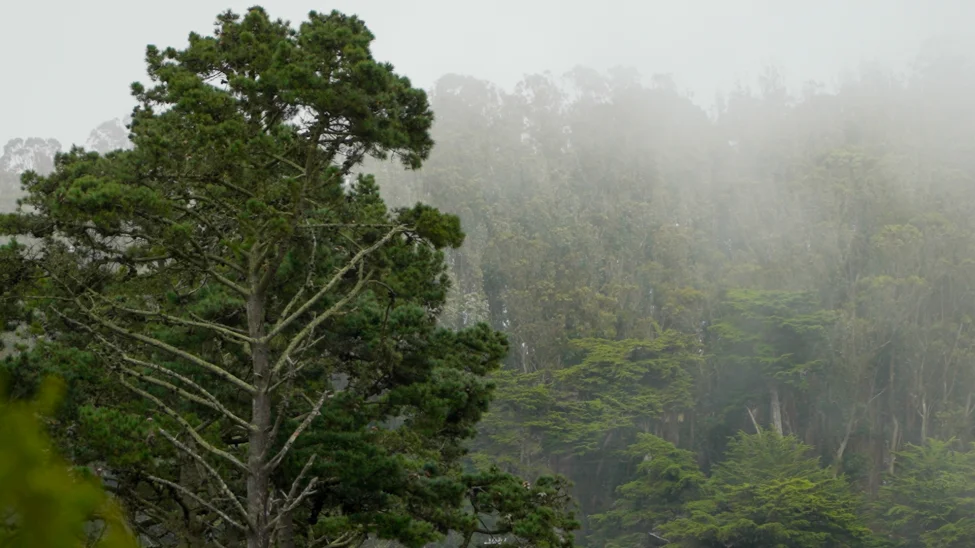

Redwoods have long been thought to get a lot of their water from fog. Dawson was able to find chemical evidence of their reliance on fog by comparing water molecules in the tree rings with the water he captured from fog in the air.
«We can put a core into a tree and we can look at the rings,» he explained. «Fog water has a very distinct H2O signal compared to rainfall. … We pick those up in the tree.»
By drilling tiny holes into trees and pulling out thin columns of wood to analyze the chemical signature of the water in their rings, Dawson determined that redwoods get a lot of their water from fog — but a little less every year.
«You can see a climatic change in the tree ring record, and that fog signal has abated,» he said.
What Can We Use Water For?
Redwoods may be the natural world’s best example of efficient fog collectors, but many plant species can benefit from fog. Even hardwoods like oak trees can absorb some water from fog through their leaves and branches. But on the campus of Cal State Monterey Bay, some recently planted oak saplings are getting a little extra help absorbing the fog from Dan Fernandez, a professor in the department of applied environmental science.
Next to each tree sits a tall rectangle of plastic mesh, stretched taut like a screen door, with a metal trough and a funnel at the bottom. Fernandez explained the devices are fog collectors, much like Dawson’s, but bigger. They catch moisture from the fog and deliver it directly to the roots of the young trees.
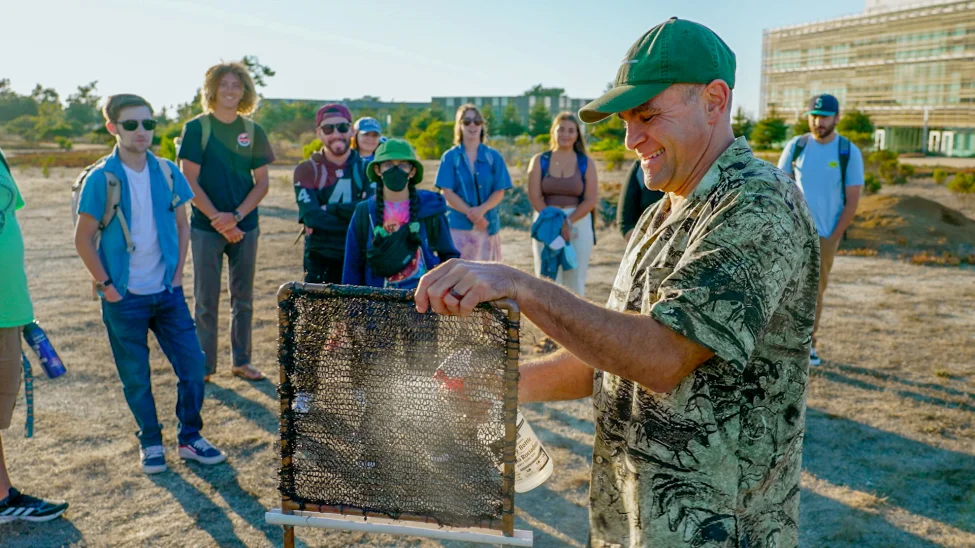

Dan Fernandez, a professor at Cal State Monterey Bay, uses a miniature fog collector to show students how droplets accumulate on the plastic mesh before falling into a collection trough under the influence of gravity.
«The droplets get captured on the mesh,» he explained to a small group of students, using a miniature model of a fog collector and a spray bottle to demonstrate. «And then as they get larger and larger, they reach the point where gravity takes over, and pulls them down.»
Fernandez said there’s a surprising amount of water in the fog that can sweep through campus at night or early in the morning.
«When we have a fog event, (the oak saplings) may get a couple of liters of water during that time, that they wouldn’t have otherwise gotten,» he said.
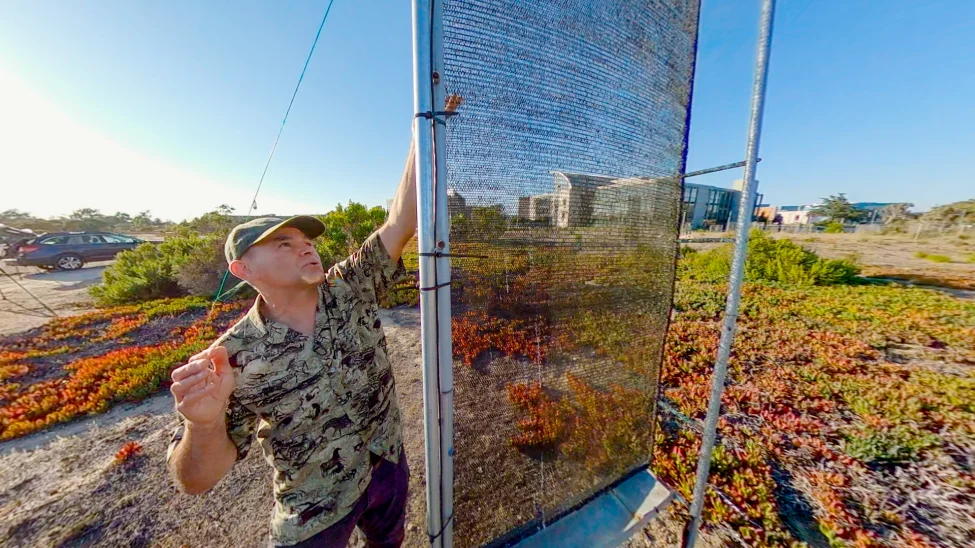

Dan Fernandez shows off one of the large fog collectors feeding moisture to oak saplings behind the main library on campus. The device has about 2.5 square meters of mesh to capture water droplets from the fog that blows through it.
A lot of Fernandez’s research is centered around the «how,» «when» and «where» of capturing water from fog. But when asked, «why?» Fernandez does what any good teacher would do: He answers a question with a question.
«I guess the answer to that question is: what can we use water for?» Fernandez replied. «Really, anything we can use water for, the water that we collect from fog, we can use that for. The question is: is there enough to make it worthwhile?»
And that second question has drawn interest from all over. Researchers from engineering schools including Virginia Tech and MIT have sent prototypes to Fernandez for testing in the California fog — which moves faster and contains more water than fog that occurs on the East Coast, Fernandez said. Getting the most water from a fog collector is a matter of materials, placement, orientation and, of course, size. And just up the road at U.C. Santa Cruz, an experiment is underway to test the effects of each of those variables — especially the last one.
Growing Tomatoes and Hope
«Farms use a lot of water, of course, and some of that water could be harvested from fog,» explained Peter Weiss-Penzias, a faculty researcher at U.C. Santa Cruz.
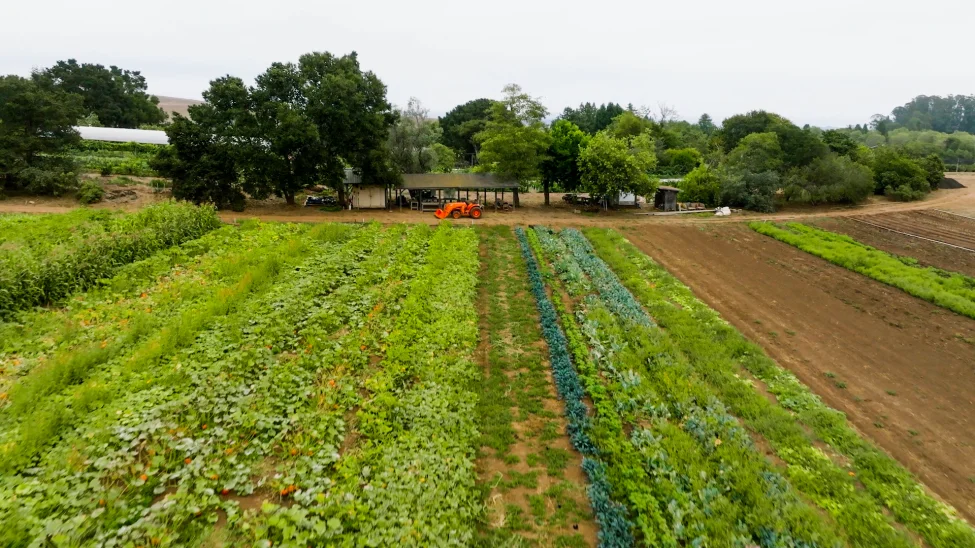

U.C. Santa Cruz operates a small working farm that’s used to conduct a wide variety of agricultural research.
Weiss spoke to us on the university’s very own farm, used for all sorts of agricultural research, and situated not far from the Pacific Ocean, where the fog begins its journey. At the edge of the farm, Weiss and his students have built a tall wooden structure consisting of three large rectangles covered in black plastic honeycomb mesh. It’s a fog collector with a total size of about 13.5 square meters. And it’s an experiment being conducted in direct response to California’s recent string of unprecedented droughts.
«This thing’s really efficient at collecting the fog, so it drips off pretty fast,» Weiss explained.
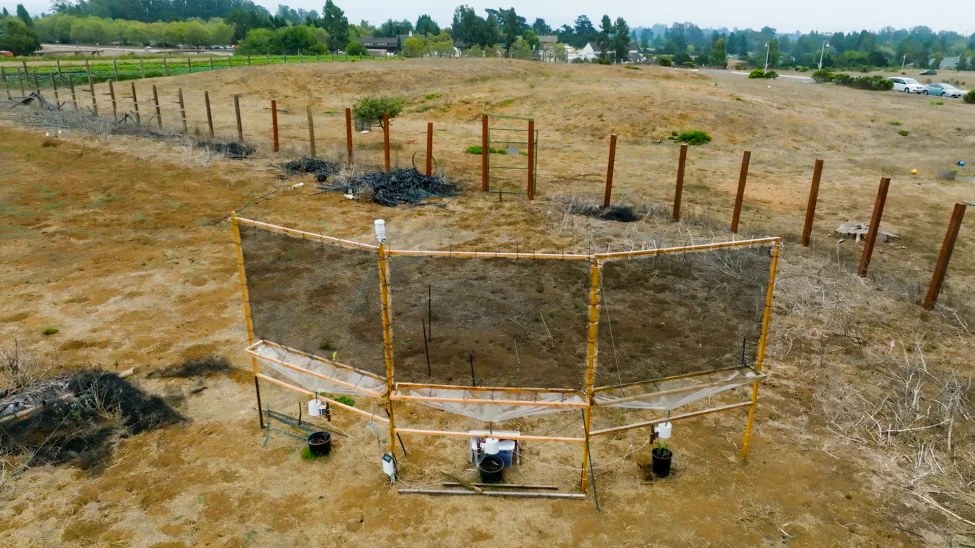

Peter Weiss-Penzias and his students designed this extra-large fog collector, with about 13.5 square meters of highly efficient plastic mesh, and covered it with scientific instruments to better understand the water content of California’s coastal fog.
Up close, the mesh is an intricate pattern of thick and thin strands, braided together. It’s designed in Germany, Weiss explained, and it mimics the needles of redwood trees.
«Something called biomimicry, where it uses these small filaments that lead to larger filaments,» he said. «Because especially redwoods, they have evolved with the fog.»


The mesh covering the large fog collector on the U.C. Santa Cruz farm is designed in Germany to mimic the water-catching properties of redwood needles and other highly-adapted organisms, using a design philosophy known as «biomimicry.»
The structure is covered in scientific instruments, and each morning, it’s covered in water. The water goes into a rain gauge to be measured, and then falls into the soil where Weiss is growing a handful of potted tomato plants.
«We’re getting approximately five liters of water per night,» Weiss said with a slight smile.
The tiny tomatoes are starting to sprout, and with them comes hope, Weiss said, that the fog might not be just a victim of climate change: it could also be a solution.
The Driest Place on Earth
California isn’t the first place to experiment with harnessing the water in coastal fog. At U.C. Berkeley, a meeting convened in September to host a group of visiting scientists from Chile, a country where fog collection is nothing new.
«We have been doing this for several decades already, since the 80s,» said Juan Luis Garcia, a geography professor at Universidad Catolica de Chile, often abbreviated U.C. Chile (but not affiliated with California’s U.C. system).
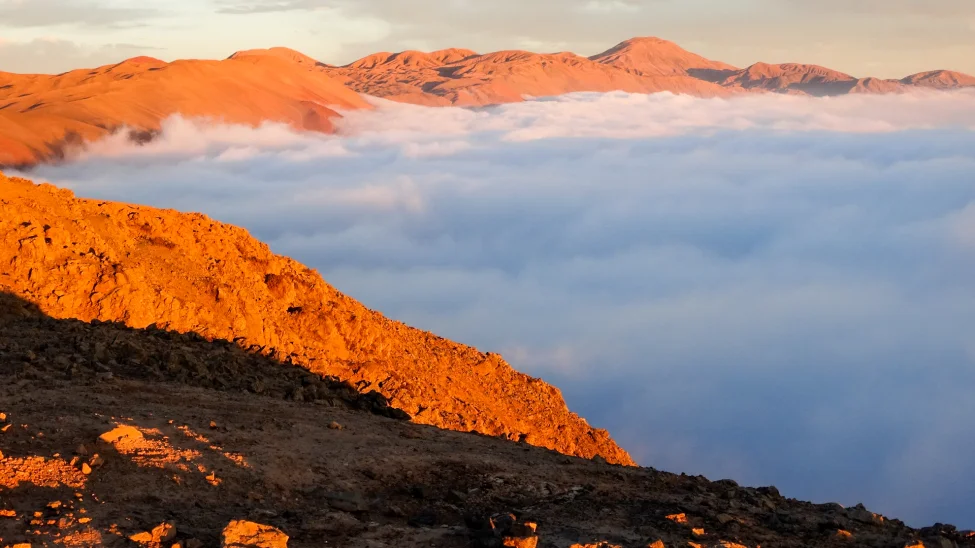

Known as the driest place on earth, Chile’s Atacama Desert sees almost no rainfall — but it does get fog.
Chile is home to the Atacama Desert, known as the driest place on earth. And there, U.C. Chile operates a remote research station that gets all of its water from fog.
«So when you cook, when you go to the bathroom and take showers, it’s all fog water,» said Sergio Guitart, U.C. Chile’s executive officer of field stations.
Pablo Osses, who runs the Atacama research station, said it’s high quality water with a unique flavor from the minerals it carries.
«It’s tasty,» he said. «It’s a bit sweet.»


An academic research station in Chile’s Atacama Desert relies entirely on fog for all of its water needs. Water is captured from fog using the two large nets on the right.
But Osses said Chile’s environmental researchers can’t take credit for being the first to capture fog. Anthropologists have pieced together evidence that indigenous people in what’s now Chile were capturing water from fog up to a thousand years ago. Researchers found remnants of clay vessels placed at the bottom of flat rock faces covered in lichen — the colorful, moss-like organisms that are a cross between an algae and a fungus, and can sometimes have a hairy texture.
«So the lichen works like hair, catching the drops, and then (the drops) start falling … by gravity,» Osses explained.
People who wanted to capture the water would place clay bowls or sometimes leather bags at the bottom of the lichen-covered rocks, and wait for the water to fall into them.
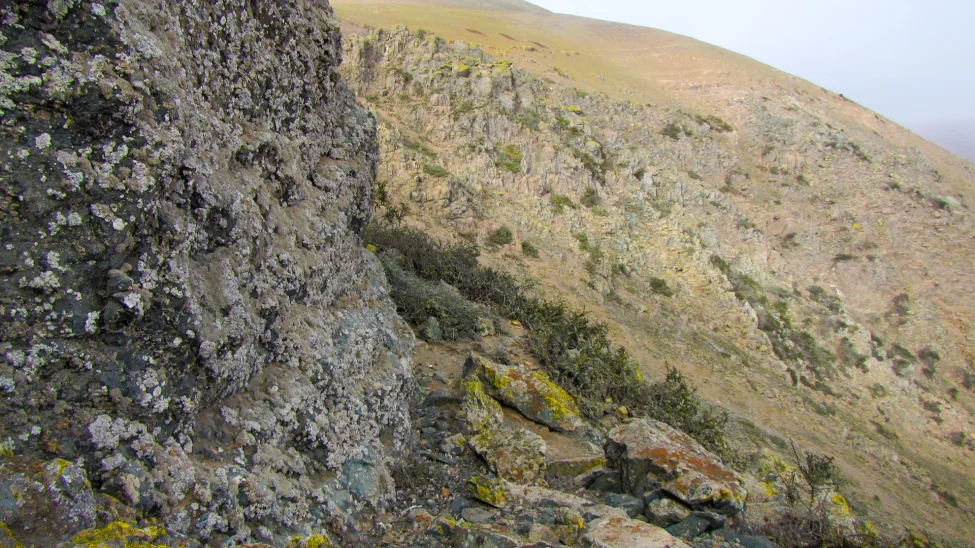

Anthropologists have found evidence that indigenous people in South America were collecting water from fog up to a thousand years ago, by setting clay vessels and leather bags at the bottom of rock faces like this one. The lichens that cover the rock can act like sponges, catching and holding moisture from fog until it’s heavy enough to drip off and fall to the ground.
A Tower of Fog
Chile and California are known as «transhemispheric twins:» two places with strikingly similar environmental features, on opposite sides of the equator. Because of their similar weather patterns, what works in Chile has a good chance of working in California — and that’s capturing imaginations, even outside the usual fields of study that focus on weather and water.
«Sutro Tower’s just giant,» remarked Eduardo Bendek, an optical scientist at NASA who attended the U.C. Berkeley meeting of visiting scientists.
The iconic communications tower on San Francisco’s second-tallest hill is often swallowed up by fog on summer afternoons. Bendek ordinarily studies the physics of space telescopes, but a recent physics project with one of his students landed right here on our own planet, envisioning Sutro Tower as a giant fog collector.
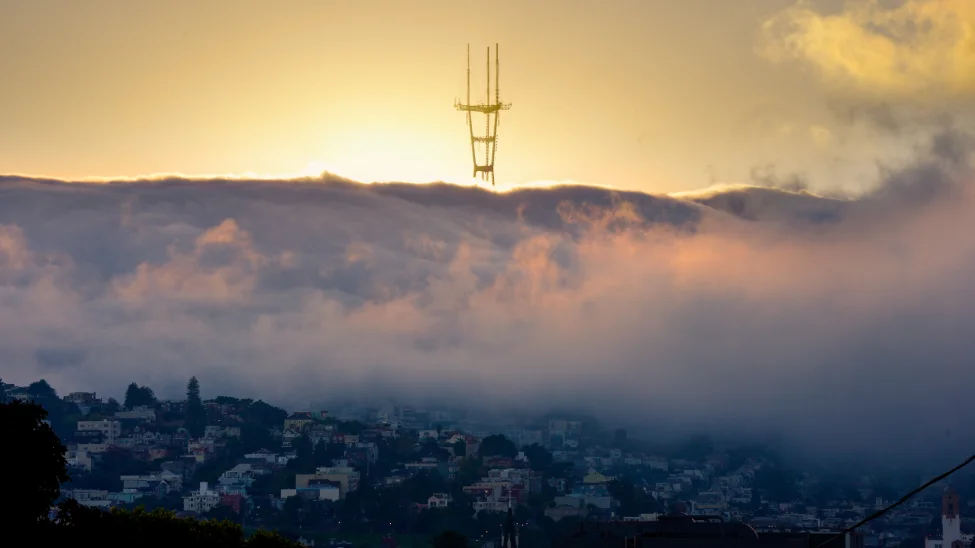

Sutro Tower, the iconic communications tower on San Francisco’s second-tallest hill, might be in an ideal place to serve as a prototype giant fog collector, providing water to parks and neighborhoods on nearby hillsides, according to one scientist.
«You can think on the order of 5,000 gallons a day — which is not bad,» Bendek said.
The plan would call for retractable sheets of plastic mesh to deploy up and down the tower’s structure when it’s foggy out, and roll away when the skies are clear. Bendek envisions using gravity to feed the water to neighborhoods and parks on the adjacent hillsides.
«You have this source of water in the fog, that occurs in summer, when there’s a lack of water here in California,» Bendek said. «We have a drought, so let’s do something about it.»
Fogtober
We spoke a few weeks after the historic Labor Day heat wave, watching the tower become completely enveloped by fog throughout the course of our conversation. During a month that’s historically sunny and warm, Karl the Fog proudly announced his unexpected return to the city on social media, proclaiming it the month of «Fogtober.» Karl did his best to ruin spectators’ view of the Fleet Week Parade of Ships that month, and for the first time in recent memory, Karl wrought havoc on the Blue Angels‘ air show three days in a row.
It turns out that since Dawson’s first study, the fog has made a bit of a comeback — though not always during the months San Franciscans have come to expect it. And what’s more, some of the foggiest years have been the ones in which California needed water the most.
«When we had the drought between 2012 and 2016 here in California, there was actually a tick up in the amount of fog for that four-year period,» Dawson said.
«The question remains, will climate change always result in less fog?» asked Fernandez. «Maybe it’ll result in more fog at certain times, and then eventually less fog.»
And if it’s true that more fog might show up just when California needs water, then Bendek points out that the Blue Angels can teach us something about how to best collect that water.
«When the Blue Angels fly, and they pull a lot of G’s, you see this little fog running on the wings,» Bendek said.


When fighter jets are going fast, fog can form on the wings. The spot where fog is the thickest, a bit behind the leading edge of the wing, is a good illustration of where a fog collector might be most efficient on land: Just behind the crest of a coastal hill.
Sometimes it shows up as fog trails on either side of the cockpit, he said. At other times, it shows up as a straight line of fog, just behind the leading edge of the wings. And that’s the teachable moment, Bendek says — because it illustrates the best place to put a fog collector. If a coastal hill is like a giant airplane wing, with air and moisture running over it as it comes in from the ocean, then Bendek says fog could be most effectively collected just behind the top of that hill — a little ways down the slope that faces away from the ocean.
«It’s where it’s most likely that the water density will be the most,» he said.
Bendek said he could envision retractable fog collectors lining the hills of the Bay Area coast one day. It could take decades of environmental studies and major regulatory changes in order to happen. But there’s an important small step that could happen first — and it’s just on the horizon.
Save Every Drop
«If the drought continues like it is, we’re going to be looking for all different ways to save every drop,» said Joshua Cosgrove, the acting water director in the water district that serves the foggy community of Daly City, just south of San Francisco.
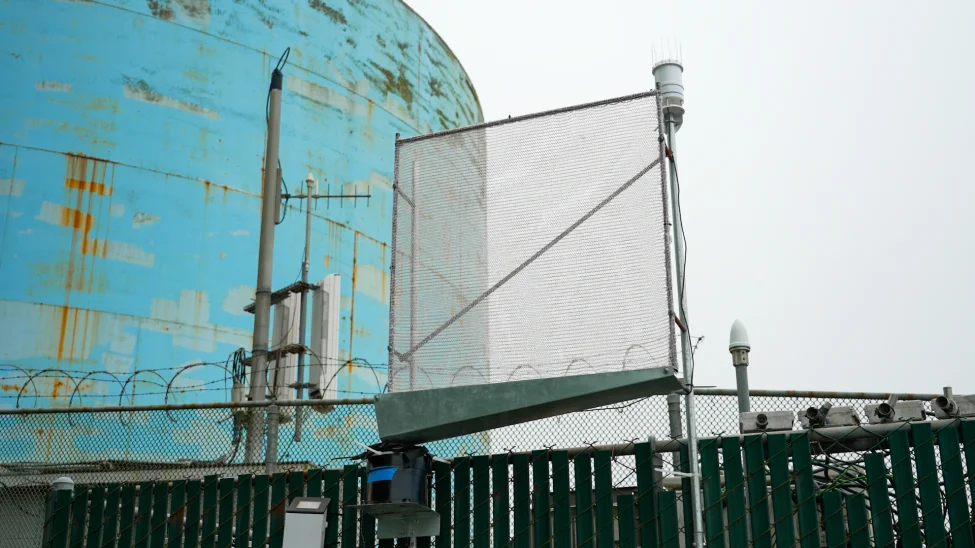

A small fog collector measuring about one square meter is mounted on a fence near water tanks in Pacifica, counting the droplets of water that could be available to residents there if they were to collect fog at their homes.
Working with Weiss and Fernandez, Daly City and the neighboring community of Pacifica are already taking measurements, with small instrumented fog collectors on their foggiest hilltops.
«We have a lot of customers that potentially might be interested in putting a fog collector in their backyard,» said Adrienne Carr, the general manager for Pacifica’s water district, the North Coast County Water District.


Pacifica and Daly City are known to be some of the Bay Area’s foggiest communities, and also have a lot of homes with backyards. Water managers there think offering at-home fog collection kits could give residents another way to save drinking water during the next serious drought.
The two suggested that fog water could be used in much the same way as stored rain water: to water lawns, flowers and fruit trees, offsetting domestic water usage the way solar panels can offset a household’s need for electricity from the power grid. If the measurements show promise, they’re prepared to look into offering fog collection incentives in the same way water districts in San Mateo County offer rebates for installing rain barrels.
«Potentially get kits together, and people can build them themselves,» Carr suggested.

Summertime fog casts a gray shadow over homes in San Francisco’s Richmond District at sunset.
Is This Where They Make Fog?
The Bay Area might be at the beginning of a long journey when it comes to harnessing the fog — and protecting it. But for Nancy Hale, the mission is much smaller than the vast Pacific ocean or the mighty Golden Gate Bridge.
For her, it’s about a future where her grandkids — and their kids — can cross that bridge into a city that’s painted in shades of gray, just like one of Marcelo’s landscapes — as they wonder where it all comes from.
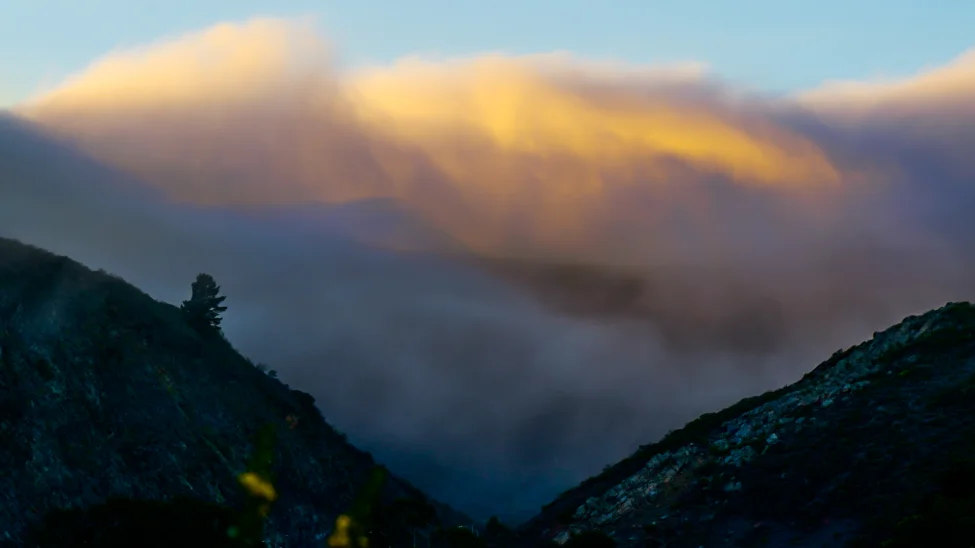

Fog pours over the Marin Headlands, filling up the space between two hills along the southbound approach to the Golden Gate Bridge. Nancy Hale’s grandson asked her, «Is this where they make fog?»
«My grandson said, ‘Is this where they make fog? Right there?'» she said, gesturing to the hills at the north end of the bridge where thick fog pours down the slopes. «And I realized, see? Another generation, starting his own relationship and his own story about fog.»
Medio: NBC